Miracle Eagle Rescue
I drum my fingers on the steering wheel, close my eyes, and sigh. Another bison jam. It’s mid-August in Yellowstone National Park. Three cows saunter along the double yellow line, stopping traffic in both directions. A monster diesel truck crawls past in the opposite direction. A dog has squeezed his head through the tangle of outstretched arms holding cameras and phones out the open windows and barks at the bison. I stop because the car in front of me stops and then I see it.
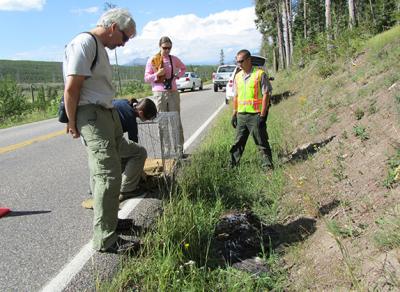
To my right, low in the verge, there is movement. A head rises and falls back to the ground. “Oh my God, it’s a raptor of some kind. It’s injured!” I shout to my biologist friend, Eric. Together we watch as it raises its head again. “We have to help that bird!” He jumps out of the car and steps into the grass. The bison are still getting lots of attention and no one else has noticed the bird.
“There’s no blood, and his wings look intact,” he reports, “I think he can be helped, but we need to get him out of here. He may have been hit by a car.” He adds, “It’s a juvenile bald eagle.”
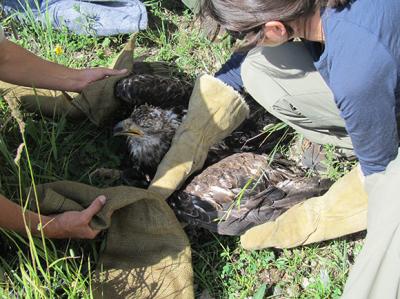
“Stay with him and I’ll go call for help!”
I drive off towards a spot about three miles away where I know I can get a few bars on my cell phone. I dial 911 and reach park dispatch.
“911, what is your emergency?”
“I have a wildlife emergency! I’m a guide in the park. There’s an injured eagle by the side of the road. We think he was hit by a vehicle. My friend is a biologist and is with the bird,” I add, hoping to be taken seriously. “He thinks he can be helped. May we have permission to transport him?”
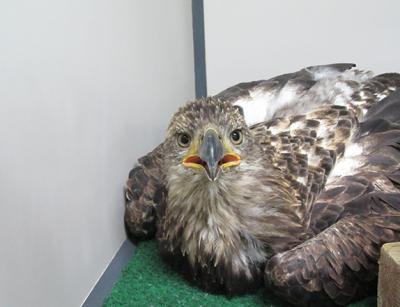
There is a tricky park policy involved here. If an animal is injured naturally, no intervention would be allowed. Likely this bird was hit by a vehicle, human caused, and intervention would be justified. Plus, bald eagles are protected under the International Migratory Bird Treaty Act.
Not unexpectedly, the dispatcher responds, “Do not transport the bird.”
“Will you notify the park ornithologist and send someone out to help him?” I ask. She agrees. My biggest fear now, other than that he will be dead by the time
I get back, is that a law enforcement ranger will respond or happen by and “dispatch” him before help arrives.
When I get back, the full August afternoon sun is baking him. He’s panting. He has engaged the nictitating membrane that protects his eyes and spread his wings on either side for stability and ventilation. He’s weaker than when I first saw him. Eric and I stand with our backs to the sun in front of him to give him shade and wait. I talk to him. I tell him he’s going to be OK, that I’m not going to let him die. I tell him he’s beautiful; that I’m so sorry; that help is coming.
It takes about five years for a bald eagle to grow a crop of white feathers on its head and tail. Until then, an adolescent’s feathers are a mottled gray, brown, and white. He’s out on his own hunting and establishing territories but is still young and inexperienced. This one has learned a hard lesson about the road.
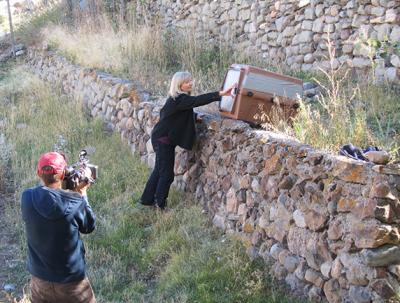
I keep glancing to the north and about 45 minutes after my call, I see a big white pickup truck. Government plates — yes, cage in the back — fabulous. It pulls over and the park ornithology tech jumps out. She shoots me a concerned glance, dons heavy leather gloves, and steps up to the bird.
“Oh, my God,” is all she can say.
We wrap him in the green fleece throw I keep in the back of my car and lay him in the cage. He does not resist.
The Montana Raptor Conservation Center in Bozeman, Montana, some 80 miles away, has agreed to take him. There is no time to spare. His condition is very critical. Eric and I follow until they leave the park.
Our first report from the Raptor Center comes early the next day. It is sobering. They have performed a CAT scan. The good news is that he appears to have no broken bones, amazing considering the extent of his other injuries. But his lungs are filled with fluid and he has extensive internal bleeding, consistent with the hypothesis that he had been hit by a vehicle. The thought now is that he was hit by the upper box of a high profile vehicle, maybe as he swooped low over the road. He is pooping blood. He is on IV fluids. The next few hours will be critical. His chances are about 50/50.
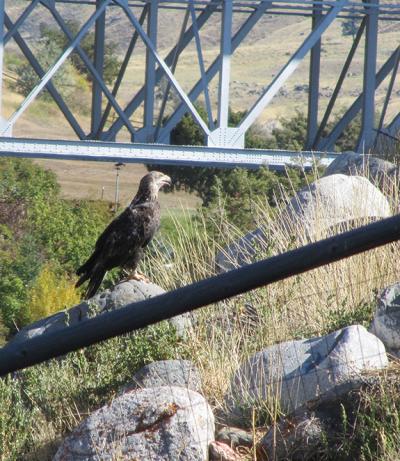
Yet, he makes it through another night and his prognosis improves with every day. A week later the staff is calling him “Miracle Bird.” I visit him at the Raptor Center in Bozeman. When I arrive, Becky is about to feed him his first solid food: raw songbird flesh, raptor sushi. She asks if I would like to feed him and I cannot refuse. We enter the intensive care portion of the refuge. He’s in a large cage, the door covered to protect him from light and activity. She opens the door and steps back so I can see him. He is still too weak to perch so he is lying on his side on Astroturf, head down.
A bowl of water is nearby. He must try to drink on his own now that the IV has been removed. “There you are, my beautiful boy,”
I say spontaneously. He raises his head and looks right at me. For the first time I see his penetrating eyes. There is no doubt in my mind, he recognizes my voice. Tears sting my eyes and my heart pounds. This bird is going to make it. I offer him some bits of meat but he’s not ready. He has a long journey ahead.
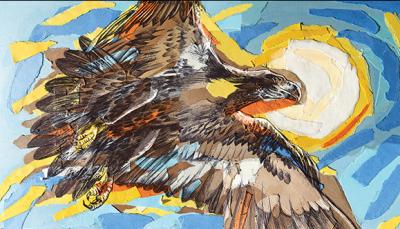
Eric joins me for my next visit three weeks later. Our bird has graduated to a much larger accommodation, a space the size of a living room with a perch on each end so he can begin to exercise his wings. He eyes us curiously but is not yet willing to show off for us. Because the accident has not caused him an injury that will prevent him from hunting and because he is young and resilient, Becky tells us he is a good candidate for release back into the wild. This is very welcome news! He will still need time to grow stronger, ultimately graduating to the flight barn. As we leave, Becky asks us if we would like to be part of his release. She really doesn’t have to ask.
On October 13th, two months after we found him by the side of the road, he makes the 80-mile return trip to Gardiner, Montana, in a dog kennel. My home, less than a quarter mile from Yellowstone National Park and about 10 miles from where he was found, is well within the limits of his range. I have the honor of opening the kennel to return him to his home. He backs out, a little awkward, but he manages. He flies to the fence, pauses briefly then perches on a large boulder just on the other side. He stops, looks back at us well-wishers, lifts off gracefully, and takes flight up the Yellowstone River. I watch him as long as I can, until he disappears into the park.
It isn’t often that a human life and a wild one touch as closely as his and mine. A touch of miraculous some would say. The best miracle of all is that this bird’s story has a happy ending.He remained wild and I will always carry the memory of the encounter close to my heart.








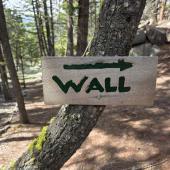
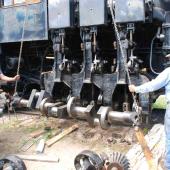
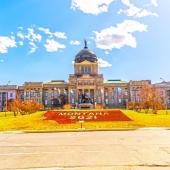
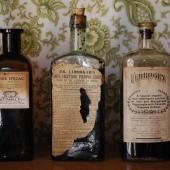
Leave a Comment Here